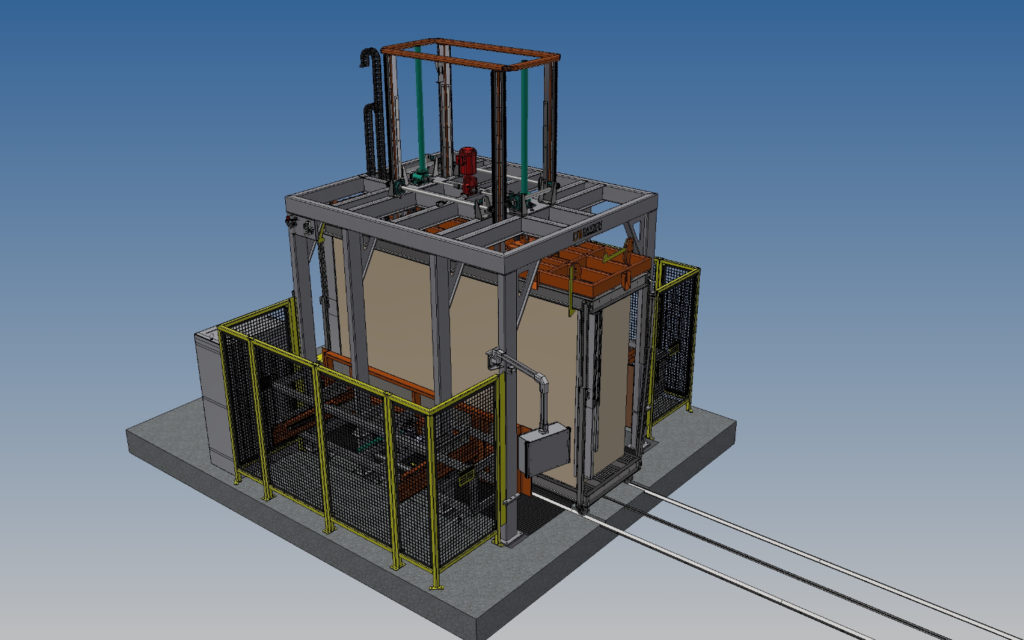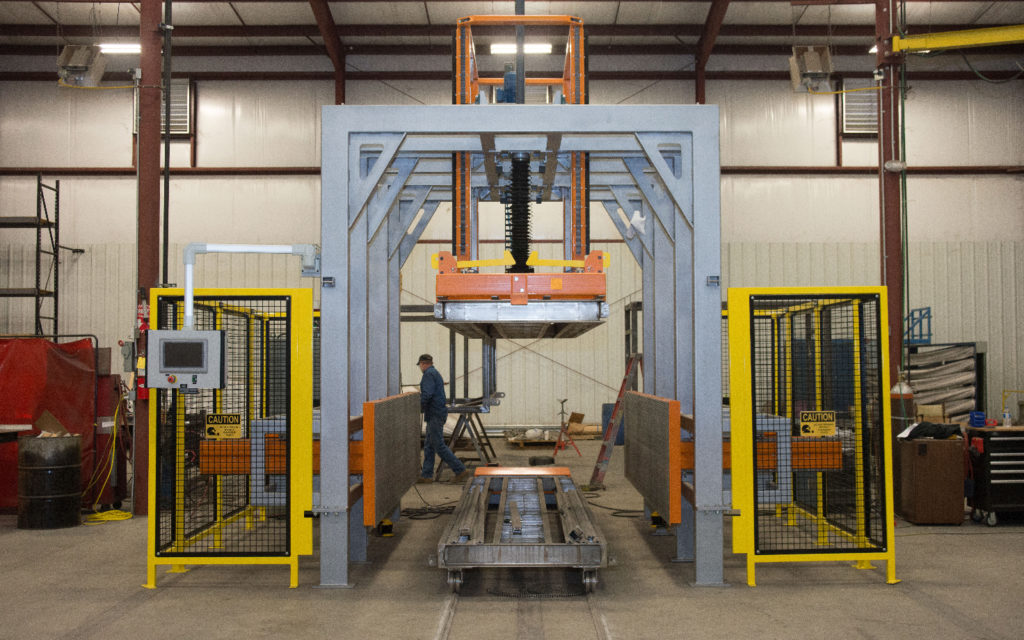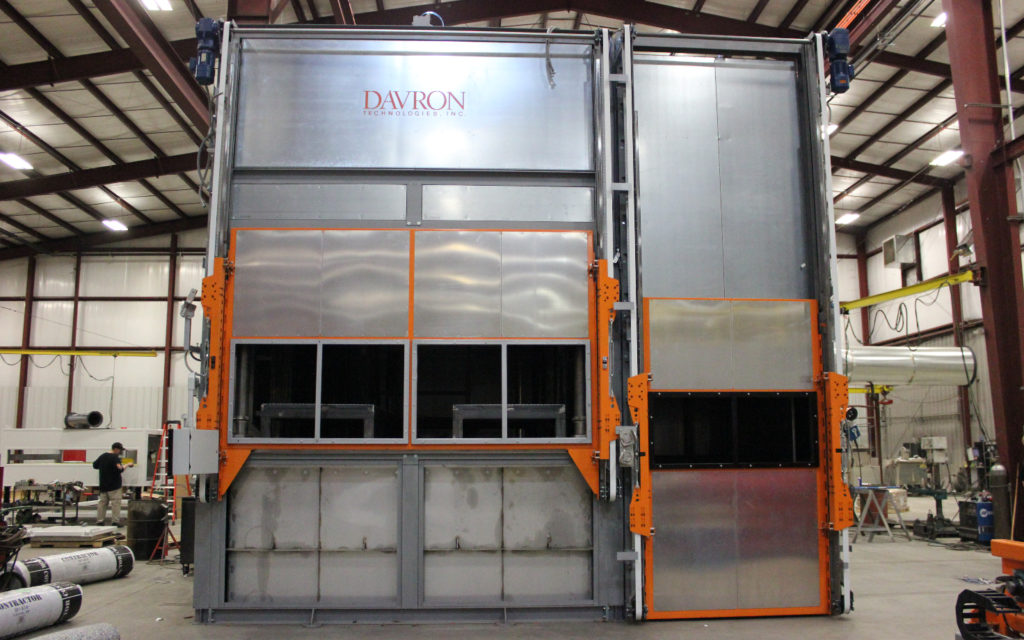As aerospace manufacturers find more and more applications for honeycomb-type composite materials, they inevitably wrestle with which thermal processing method is best.
We’ll talk more about each a little later on, but generally speaking, you can make honeycomb composite blocks in one of two ways.
Co-curing aerospace composites involves the simultaneous stabilization, resin impregnation and curing of an expanded matrix in a single, comparatively more complex, system.
Post-curing aerospace composites breaks the process into two defined stages. An expanded matrix is first placed into a stabilization mold where it is dried, and then it passes to a dip tank where resin is applied. After resin is applied, it is cured in a curing oven.

Once blocks are cured and pressed into their final dimensions, they move onto further fabrication.
(View examples of composite ovens and equipment we’ve built here.)
Whether one process is superior to the other is not something we can answer. It’s up to manufacturers to determine this based on their unique products and processing requirements.
But the best insight we can provide comes from our own experience, which we acknowledge has been limited to manufacturing two-step post-cure systems. We think this method is a strong option for the reasons detailed below.

Why post-cure aerospace composite processing is a strong option
Even though we usually advocate for consolidating thermal processing equipment to save space, operate more efficiently and provide a more cohesive processing environment, the two-step post-cure process comes with key benefits that aerospace oven buyers might find compelling.
First, separating the processes helps facility teams troubleshoot part quality concerns by making it easier to know where and how a problem occurred. In co-curing, everything happens at once in a single system. The sources of problems that might occur in co-curing risk being obscured because there’s so much happening at once. In other words, there’s too much noise in the data.
Second, it is easier to adjust process parameters in a two-step system if manufacturers want to fine-tune processing to influence product quality. They get better certainty that the adjustments they make will achieve desired results with less risk that myriad other parameters jostle the process in ways they do not intend.
Third, automating two-step processes is easier. Again, with so many processes happening at once in a co-cure system, such a system requires more complex programming that creates more ways to fail. Failure risks associated with programming errors are mitigated somewhat when they are spread between separate systems.

But co-cure composite manufacturing does have its benefits
And the biggest one we can envision is the smaller footprint. We normally prefer to engineer comprehensive systems that confine industrial ovens and some pre- and post-processing equipment to the most efficient footprint possible.
But if the amount of production per square foot is crucial to your decision-making, you should take a hard look at co-cure systems. This is especially the case as aerospace manufacturers respond to ever-increasing demand for these innovative products while also grappling with the very high costs of expanding manufacturing facilities. A million bucks for a co-cure system might be easier to stomach than tens of millions for a plant addition.
While we’ve never made any, we don’t see a reason why co-cure systems would be any harder to engineer or more expensive to build compared to two-step post-cure systems. We speculate the same for part quality: Assuming a customer has its automation in order, and assuming its co-cure system delivers sufficient temperature and airflow uniformity, co-cured vs. post-cured aerospace parts are probably indistinguishable in terms of quality and performance.
Read this primer on mass airflow for more on the precision engineering involved in building custom industrial ovens.
Finally, it’s likely that the costs to ship and install a co-cure system are lower than for a post-cure system.
How resin choice influences equipment engineering and safety
The resins used in aerospace composite thermal processing are either water-based or solvent-based. One does not lend itself to co-cure or post-cure better than the other, but it plays a significant role in the cost, speed and safety of production no matter which system type you choose.
We’ve pulled the below discussion from another article on aerospace composite thermal processing.
Resin type: Water-based
Approximate cycle temperature: 350 – 400 degrees Fahrenheit
Approximate cycle time: Up to 16 hours
Makeup air requirements: Moderate
Resin type: Solvent-based
Approximate cycle temperature: 350 – 400 degrees Fahrenheit
Approximate cycle time: Three to four hours
Makeup air requirements: Significant
Curing honeycomb material coated in water-based resins takes much longer because water evaporates more slowly than other solvents. But what manufacturers may feel is lost in an overlong cycle time they gain in an oven that is comparatively simpler to engineer, cheaper to build and much safer to operate.
For example, curing water-based resin creates much less volatile byproducts that must be exhausted. Because process cycles require far less makeup air, the makeup air intake systems don’t need to be as complex.
For another, these oven types do not require the same degree of explosion prevention, again due to the relatively low load of volatiles released as a byproduct of curing.
Solvent-based resins cure in a fraction of the time it takes to cure water-based resins. But the process results in the release of a much higher volume of volatile compounds and is therefore far more dangerous.
In these ovens, both the exhaust and makeup air requirements are significantly enhanced. Engineers must also appropriately size the ovens and their inner air distribution components so that at no point can the system reach a vapor concentration conducive to explosions.
Additionally, oven air supply design must account for exothermic conditions in cases where the specified resin will result in a chemical reaction as it cures.
Other fail-safes include:
- Redundant solvent monitors and temperature sensors throughout the system
- Automatic heat source isolation and “flooding” of clean air if an unsafe condition occurs
- Explosion relief panels that channel explosive energy upward instead of outward for operator protection
- External thermal oxidizer systems that destroy volatile byproducts
These added engineering requirements and fail-safes make ovens that cure solvent-based resins relatively safer to operate but more complex and expensive to build, particularly in the case of thermal oxidation.

How to find the right aerospace composite oven provider
Aerospace composite manufacturing remains an emerging market segment that will be subject to much more innovation in the years to come. We hope this article has painted at least part of the picture for you as you consider the processing equipment that makes the most sense for your products.
From our viewpoint, regardless of which method you choose — co-cure or post-cure — what matters most of all is that your oven provider shows they understand your unique product and process requirements. Good aerospace composite thermal processing comes down to applying temperature and airflow to meet manufacturers’ exacting specifications.
At Davron, that’s what we do best. The heavy-duty ovens we manufacture are always custom-engineered for your products, your processes and your facility.
If you’re ready to talk through an upcoming project, request a quote here. Be sure to send us any specs or drawings, too — even if it’s just a napkin sketch. You’d be surprised how many of the ovens we’ve built started out that way.






